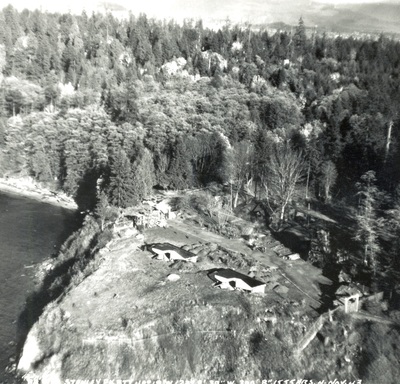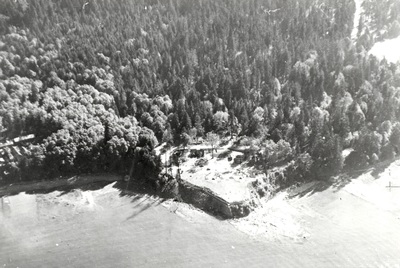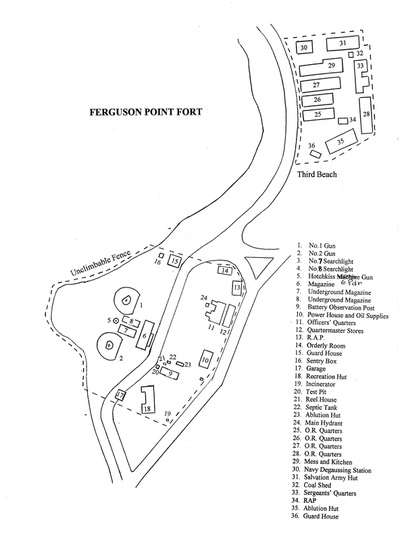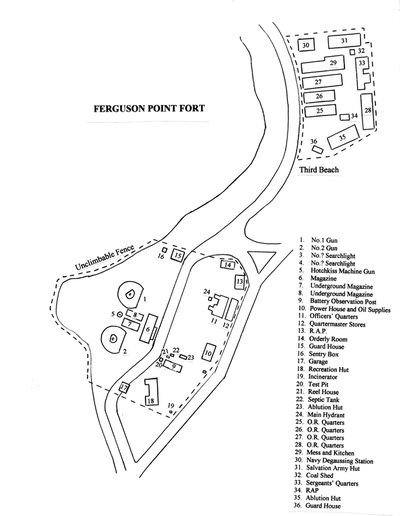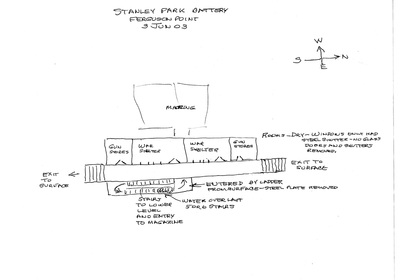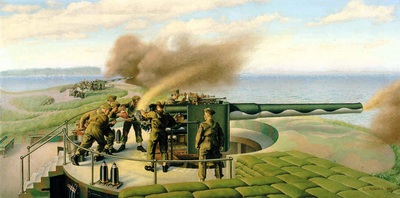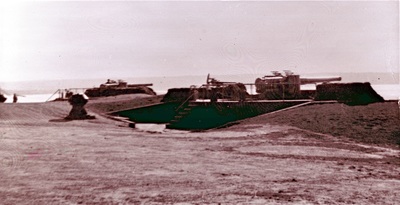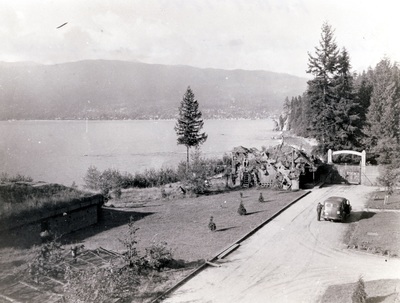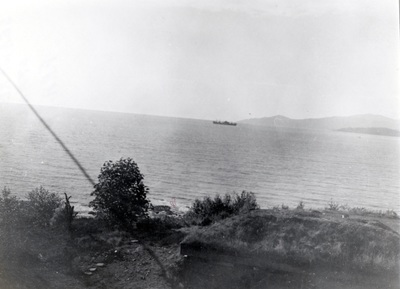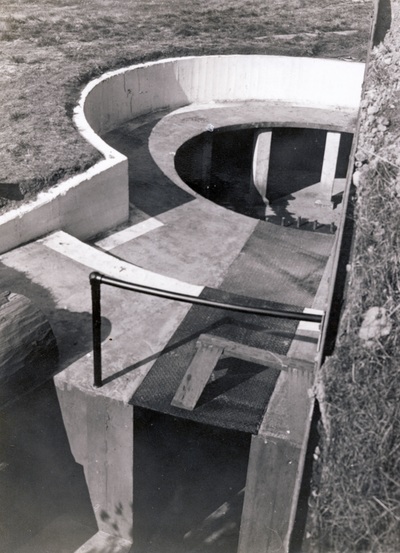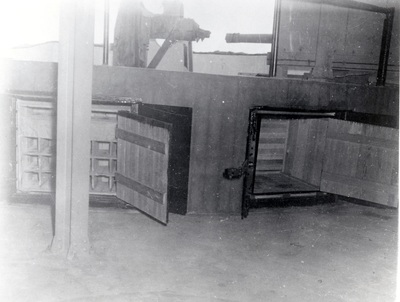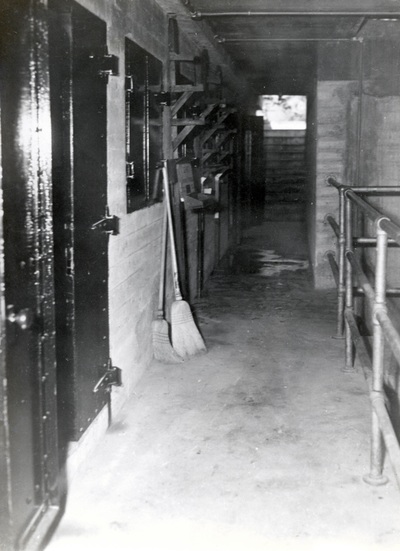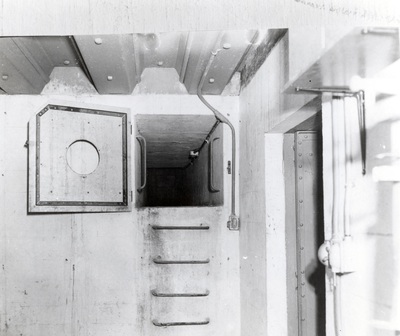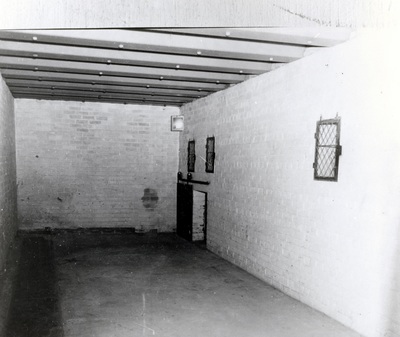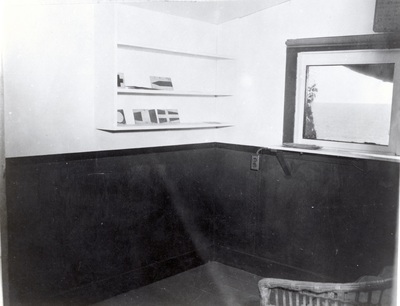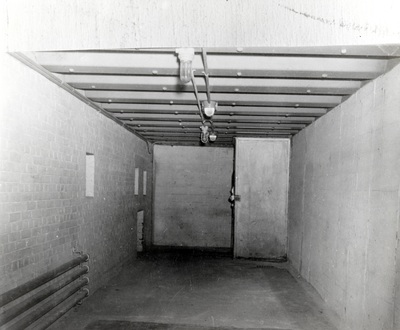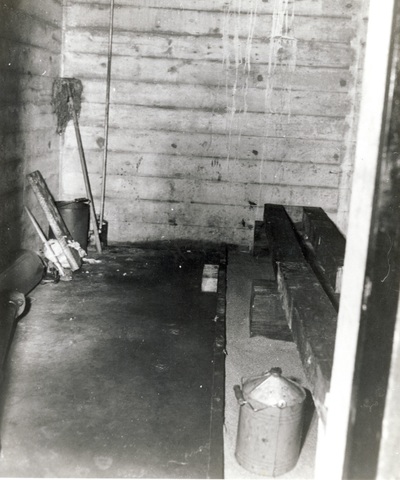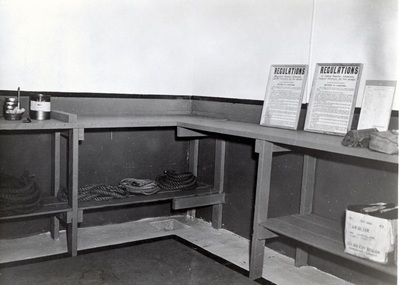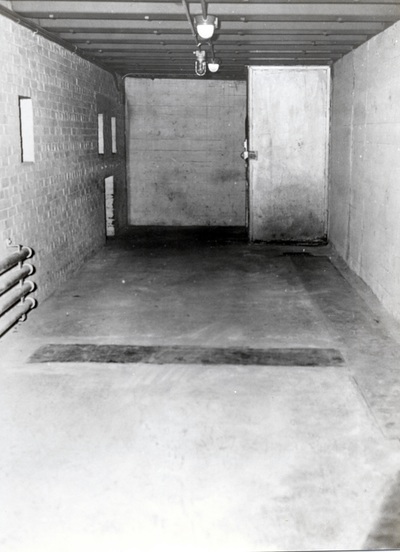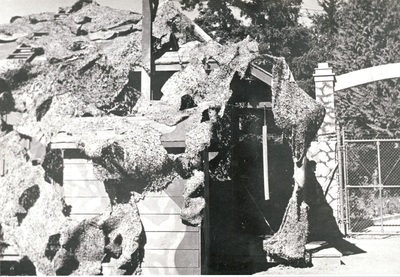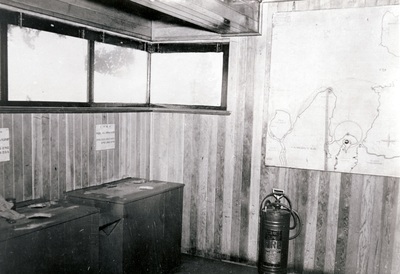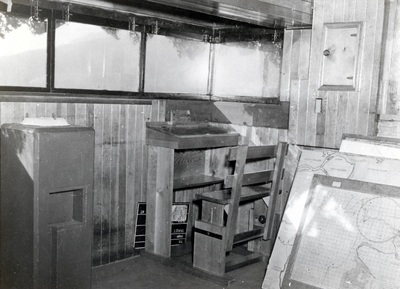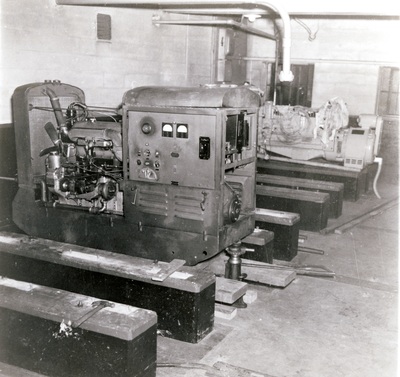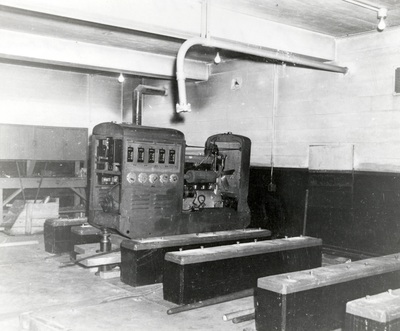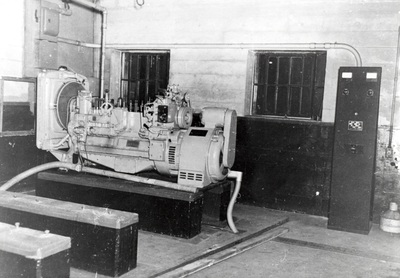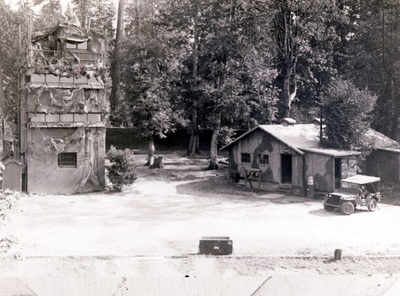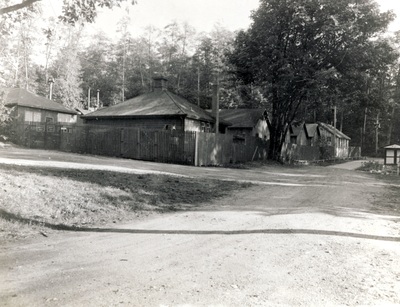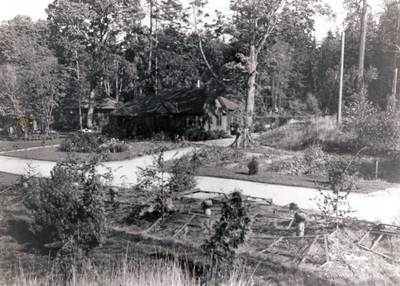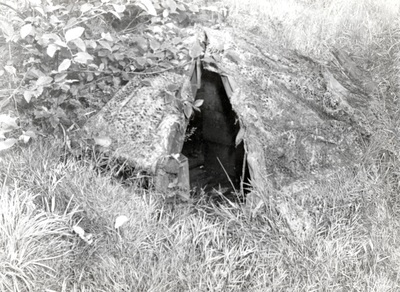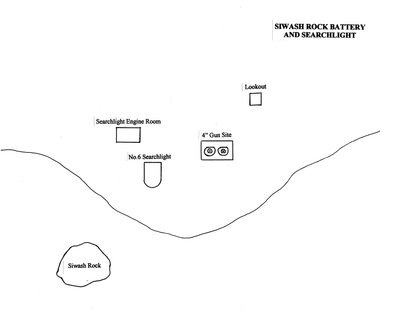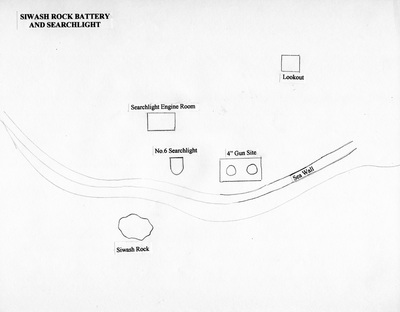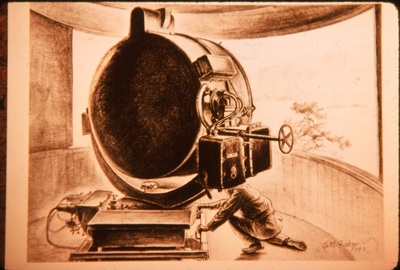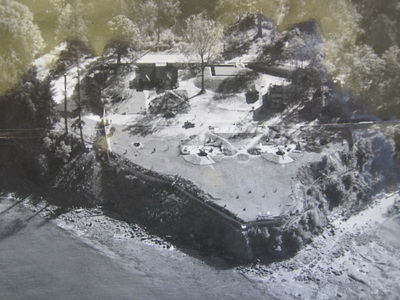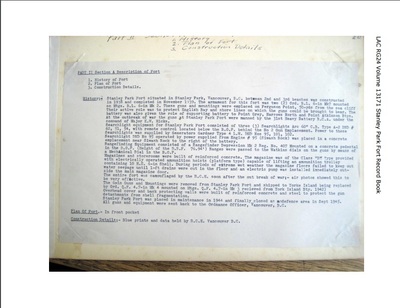Stanley Park Fort on Ferguson Point
The Stanley Park Battery was the first of Vancouver’s Second World War coastal batteries. Although the peninsula had been reserved for the defence of the First Narrows and Burrard Inlet in the nineteenth century, this federally-owned land had been leased to the city for a nominal sum since 1887. Most people knew it only as a public park. In 1914 the point of land near Siwash Rock had been occupied by a temporary gun battery when an attack by Germany’s East Asia naval squadron was considered likely. In the Second World War the Japanese navy was regarded as the greatest threat. A concrete, two-gun battery emplacement with supporting structures on Ferguson Point was planned in February 1938, after Parliament approved the establishment of permanent coast defences in early 1937. Vancouver’s role as Canada’s principal Pacific Coast port and as the transcontinental railway’s terminus justified this extra protection from hostile warships.
The Town Planning Commission, however, did not approve of the use of Ferguson Point for the battery, calling it “a favourite beauty spot in the park.” The Vancouver Sun joined the opposition and stated that the gun battery could become “a permanent blot on the scenic beauty of the area.” However, because the Parks Board had consented to the new construction, and the land really was federal government property, and the battery was deemed “essential” for strategic reasons, construction work there began in mid-February, 1938.
Vancouver’s fixed, coastal defences were to be manned by the 15th Coast Brigade of artillery, a local militia regiment. In anticipation of war, the brigade’s 31st Battery occupied the site on 27 August, 1939. The Fire Commander’s Orders of October 1942 stated that the Stanley Park Battery was to guard “English Bay and the First Narrows entrance to Burrard Inlet”, and also to act as a detaining battery for ships awaiting inspection and clearance before entering the Port of Vancouver. Like the smaller battery on the north side of the First Narrows, the Stanley Park Battery was authorized to fire on ships that refused to submit to inspection and which sailed on into the port without stopping. An examination vessel [X-Vic] was stationed two kilometres west of Ferguson Point to inspect incoming ships. After Point Atkinson’s signal station had identified arriving vessels, they proceeded to the X-Vic to be cleared for entry into the port. Large ships flew recognition signals that identified them as friendly.
The Stanley Park Battery originally consisted of two breech-loading, 6-inch calibre guns on circular, pedestal mounts. The gun emplacements were placed in from the edge of the cliff. Ammunition was stored in an underground magazine behind the guns. A concrete, three-storey, battery observation post [BOP] directed their fire. A soldiers’ camp occupied the present Third Beach parking lot. All the buildings and emplacements were camouflaged; even an evergreen tree was painted on the BOP’s front. Personnel in the BOP directed the guns and co-ordinated the two 5-foot diameter, searchlights, placed close to the water. They illuminated English Bay at night. These searchlights were maintained and operated by the 1st Searchlight Regiment’s 3rd Battery.
With the destruction of most of Japan’s major warships in 1942-43, the prospect of a seaborne attack on Vancouver diminished. Japanese submarines still torpedoed ships and shelled sites along the West Coast. Vancouver’s defences were gradually reduced to maintenance status in 1944. Stanley Park’s guns and most of the buildings were removed in September 1945. The Vancouver District’s army commander, however, continued to occupy the former officers’ mess as his home. The Vancouver Parks Board demanded Ferguson Point’s complete restoration to parkland. In April 1948 the board won this battle. The gun emplacements were levelled and buried. The BOP was demolished. The searchlight position at Siwash Rock became the base for a viewing platform. On Ferguson Point, only the old officers’ mess survives as a part of today’s Teahouse in Stanley Park.
Major [ret’d] Peter Moogk, CD, Ph.D. Museum Curator 15th Field Artillery Regiment, RCA
Note: Some of the following photographs were taken prior to 1945 as can be seen in the developing structure over the gun area.
The Town Planning Commission, however, did not approve of the use of Ferguson Point for the battery, calling it “a favourite beauty spot in the park.” The Vancouver Sun joined the opposition and stated that the gun battery could become “a permanent blot on the scenic beauty of the area.” However, because the Parks Board had consented to the new construction, and the land really was federal government property, and the battery was deemed “essential” for strategic reasons, construction work there began in mid-February, 1938.
Vancouver’s fixed, coastal defences were to be manned by the 15th Coast Brigade of artillery, a local militia regiment. In anticipation of war, the brigade’s 31st Battery occupied the site on 27 August, 1939. The Fire Commander’s Orders of October 1942 stated that the Stanley Park Battery was to guard “English Bay and the First Narrows entrance to Burrard Inlet”, and also to act as a detaining battery for ships awaiting inspection and clearance before entering the Port of Vancouver. Like the smaller battery on the north side of the First Narrows, the Stanley Park Battery was authorized to fire on ships that refused to submit to inspection and which sailed on into the port without stopping. An examination vessel [X-Vic] was stationed two kilometres west of Ferguson Point to inspect incoming ships. After Point Atkinson’s signal station had identified arriving vessels, they proceeded to the X-Vic to be cleared for entry into the port. Large ships flew recognition signals that identified them as friendly.
The Stanley Park Battery originally consisted of two breech-loading, 6-inch calibre guns on circular, pedestal mounts. The gun emplacements were placed in from the edge of the cliff. Ammunition was stored in an underground magazine behind the guns. A concrete, three-storey, battery observation post [BOP] directed their fire. A soldiers’ camp occupied the present Third Beach parking lot. All the buildings and emplacements were camouflaged; even an evergreen tree was painted on the BOP’s front. Personnel in the BOP directed the guns and co-ordinated the two 5-foot diameter, searchlights, placed close to the water. They illuminated English Bay at night. These searchlights were maintained and operated by the 1st Searchlight Regiment’s 3rd Battery.
With the destruction of most of Japan’s major warships in 1942-43, the prospect of a seaborne attack on Vancouver diminished. Japanese submarines still torpedoed ships and shelled sites along the West Coast. Vancouver’s defences were gradually reduced to maintenance status in 1944. Stanley Park’s guns and most of the buildings were removed in September 1945. The Vancouver District’s army commander, however, continued to occupy the former officers’ mess as his home. The Vancouver Parks Board demanded Ferguson Point’s complete restoration to parkland. In April 1948 the board won this battle. The gun emplacements were levelled and buried. The BOP was demolished. The searchlight position at Siwash Rock became the base for a viewing platform. On Ferguson Point, only the old officers’ mess survives as a part of today’s Teahouse in Stanley Park.
Major [ret’d] Peter Moogk, CD, Ph.D. Museum Curator 15th Field Artillery Regiment, RCA
Note: Some of the following photographs were taken prior to 1945 as can be seen in the developing structure over the gun area.
Fort Record Book - Stanley Park
The Fort Record Book contained the technical information for the fort. Armament, personnel and equipment are listed.
The Fort Record Book contained the technical information for the fort. Armament, personnel and equipment are listed.

